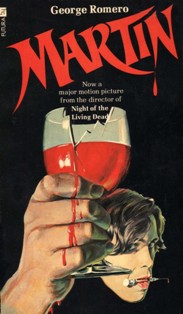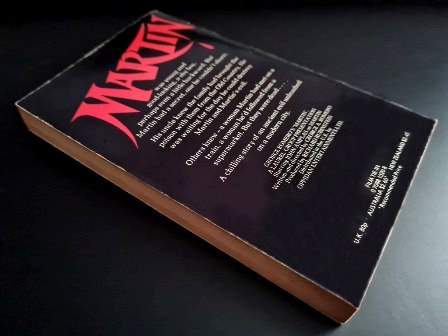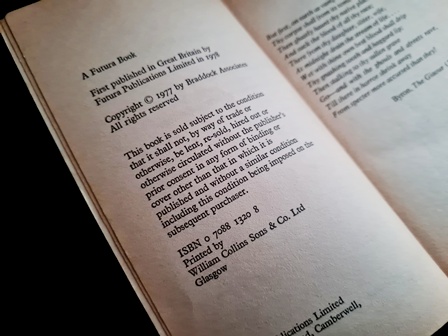
First published back in 1977 to coincide with the release of the early Romero directed film of the same title, the novelisation of ‘Martin’ was principally written by Romero himself, with additional co-writing from Susanna Sparrow (likewise with Romero’s novelisation of ‘Dawn Of The Dead’ (1978)).
DLS Synopsis:
Martin Mathias has been sent to live with his cousin Cuda Zindarich (aka Tati Cuda) after the tragic death of his previous guardian. Travelling alone by train from Indianapolis to Pittsburgh, Martin begins to feel his familiar urges kick in once again. Locating the cabin of a lone young lady, Martin breaks in to the cabin and quickly sedates the woman with a shot from a syringe that he carries about his person for just this purpose. The young man then commences to rape the unconscious victim before drinking her blood and subsequently disposing of the body. None of this practice is new to Martin, and his techniques are now honed to be efficient and more importantly, incredibly hard to pull evidence from.
Upon arriving at Pittsburgh, Martin meets with Tati Cuda who directs the quietly spoken (almost to the point of being mute) young man to another train which will take them to their final destination – the dying town of Braddock where Tati Cuda lives with his granddaughter Christina. Tati Cuda is getting on in his years now, and still holds the strong belief in the supposed ‘family shame’ - the curse of vampire blood that is sporadically passed down through their family bloodline. With this strong belief firmly in his mind, Martin is forbidden by Tati Cuda to speak to Christina or to take any victims from the local community.
The arrival of Martin is soon the talk of the town, with Martin being referred to as Tati Cuda’s dim-witted but harmless nephew. Martin is soon doing chores for Tati Cuda, running home deliveries across the town for the butchers which Tati Cuda owns. Delicate relationships begin to flower with a small number of the locals, especially with the lonely housewife Mrs Santini. At night Martin begins to build up a regular correspondence with a local radio station where he can unburden his thoughts anonymously via their ‘phone-in’ broadcasts, where he goes under the name of ‘The Count’.
However, Martin’s urges cannot be suppressed, and it’s not long before victims begin to crop up in the nearby city. How long will it be before the authorities or Tati Cuda catch up with Martin’s late night endeavours?...
DLS Review:
The novelisation of Romero’s 1977 movie follows the storyline very closely, other than with a few points, where the novel either expands on the plot, or takes a slightly different non-plot-affecting course. Examples of these would be with the murder of the first woman on the train to Pittsburgh, where Martin disposes of the body out of the train window in the book, but in the film he merely fakes the women’s suicide to avoid suspicion of murder. Similarly, later on with Martin’s early magic trick to illustrate the point of how vampirism is just fictional, Martin performs two very different tricks between the film and the novel. Indeed, a number of these small differences can be seen throughout the book.
Although the novel is not written in the first-person-perspective, it does however utilise the ability to portray Martin’s thoughts to a greater extent than the film does. This allows for a further depth of interest to the body of the story, as well as delving further into the emotional turmoil of this intriguing modern day vampire. The novel also successfully fleshes out a number of the aspects of the storyline that the film had only really hinted at. This is certainly the case with the developing sexual relationship between Martin and Mrs Santini, and in particular with the subplot that forms around the effects on the woman of Arthur leaving Braddock. The sex scenes are certainly a lot tamer within the film version, massively hindering the portrayal of Martin’s struggle with this aspect of his ‘coming-of-age’ story.
However, the storyline is not always the more extended version within the book. An example of where the reverse is in fact true would be with the fight between Martin and the man he catches having an affair with a women he had planned on targeting. The dramatic fight in the film is far more substantial and action packed, with an utterly panic driven edge to it. Indeed, in the film version, the action is spread across the entirety of the victim’s house rather than just confined to the bedroom as it appears in the novelisation.
Romero’s biggest impact with the story is in the way he redefines vampirism within the tale, creating a whole new, updated and more realistic modern-day vampire in Martin. The sun only bothers his eyes a little, whilst garlic, mirrors and crucifixes have no effect on Martin whatsoever. This redefining and updating of a classic horror monster is an idea whereby Romero has become the undisputed master. His redefining of the zombie in his classic 1968 movie ‘Night Of The Living Dead’ had far more impact on the horror genre as a whole, however, ‘Martin’ still holds a similarly dramatic redefining, creating a whole new life for the horror icon of the vampire.
All in all, as with other such novelisations, the books adds numerous additional qualities to the storyline, giving a further depth to the characters (predominantly that of Martin) whilst also furthering the explanation of the various subplots and twists in the tale. The novel continues with a moderate but gripping pace throughout, building on the intrigue of Martin’s developing emotional and social state, creating a grotesque parody of a coming-of-age tale.
The novel runs for a total of 213 pages, which includes a five page afterword by Romero in which he dissects the principals and thoughts behind the tale. The text from the afterword was later included within the inlay of the film’s DVD release.
© DLS Reviews









